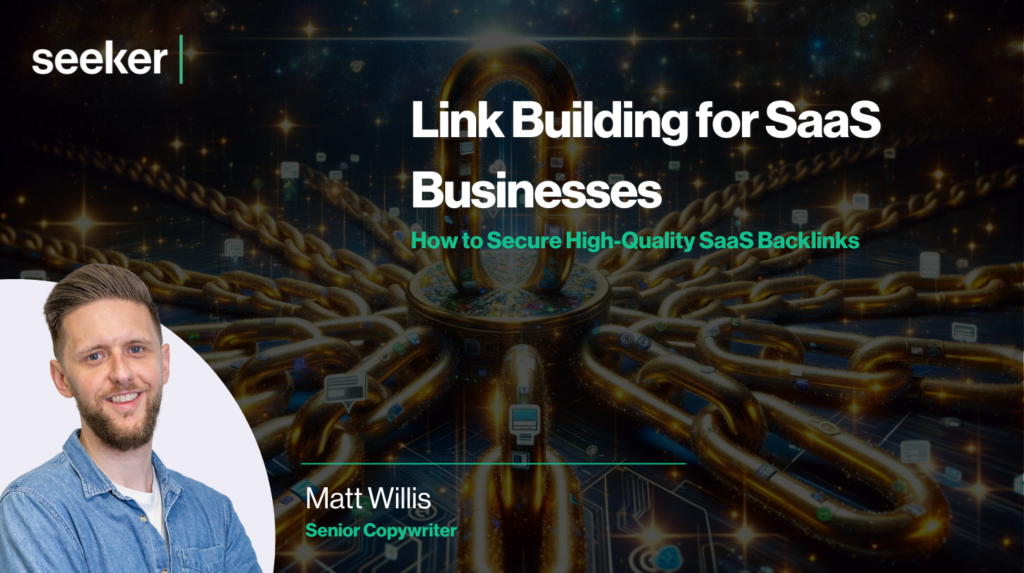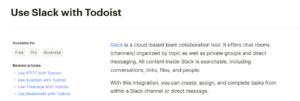
Why is link building important for SaaS brands? Well, in the hyper-competitive landscape that is SaaS, links can be an all-important differentiator between brands vying for the finite attention of consumers and businesses alike.
Sure, link building is ultimately about improving search engine rankings; but in the SaaS sphere, it’s also a strategic tool for driving targeted traffic, building brand authority, and establishing a footprint in a vast — and ever-expanding — online ecosystem.
By forging valuable connections with other sites in their niche, SaaS businesses can tap into new audiences, enhance their credibility, and fuel meaningful, sustainable growth. In a rapidly-evolving digital industry, a strong backlink profile is not merely a ‘nice to have’ but a constitutional element of a robust digital marketing strategy.
The key, of course, is building a diverse profile of high-quality links from industry-relevant, authoritative sources. The sheer number of links you build is important, but as is often the case, quality trumps quantity — a modest number of high-calibre backlinks typically holds more weight than a plenitude of poor-quality, loosely-relevant, or ‘spammy’ ones.
But what’s the real secret to developing a SERP-conquering SaaS link building campaign? How do SaaS businesses go about sourcing and securing needle-moving links from credible sites within their niche? And what’s the best approach to outreach for SaaS brands?
As an agency that’s well-versed in SaaS SEO services — having worked with many leading SaaS companies in our time — we know a thing or three about link building for SaaS. Looking to scale the SERPs and cement industry authority? Read on, as we explore 6 key approaches to securing high-quality backlinks as a SaaS brand.
Focus on creating linkable assets
The best way to attract links as a SaaS brand? Give sites something to link to. Linkable assets are pretty much as they sound — assets that naturally generate links because they’re seen as eminently link-worthy. These assets can come in many forms — from infographics to data studies — and are effective tools to have in your arsenal when it comes to building backlinks that balance quality and scale.
The aim here is to create content that is highly valuable to your target audience, but also unique and engaging enough to garner attention. This might involve identifying and addressing specific needs, pain points, or content gaps within your industry, and offering unique insights, tools, data, or solutions that are not readily available elsewhere.
And while the beauty of linkable assets is that they’re designed to attract links organically — a little like link building on autopilot — that doesn’t mean you shouldn’t put the extra effort into proactively outreaching your content to potential link-sharers, industry bloggers and influencers, increasing your chances of securing links from a range of sources.
What could a linkable asset look like for a SaaS brand? Here are a few examples:
- Guides and eBooks: Comprehensive how-to guides, white papers, and eBooks on topics relevant to your SaaS offering can be valuable resources that have the potential to attract links en masse.
- Original research and data: Conducting and publishing original research — such as a survey or industry report — can provide genuinely share-worthy findings and insights.
- Interactive tools and calculators: Tools that help users solve problems or answer questions — an “ROI calculator for investment software” for a SaaS brand in the financial services industry, for example — can attract consistent links.
- Webinars and video tutorials: More than half of B2B SaaS marketing professionals consider webinars and webcasts to be the most successful form of video content, and these can be a great way of creating engagement and building links.
- Infographics and visual data: Data visualisation is a way of summarising complex topics in visually engaging ways, and assets that do this effectively are often linked to in blogs or social media posts.
- Templates or frameworks: Pre-built templates or frameworks — a “project planning template kit”, for example — can be valuable assets to users and will often pick up ample links from external sources looking to offer useful content.
Look for opportunities for expert commentary
In a crowded SaaS space where trust and authority are crucial for generating leads and conversions, your expertise and experience are two of your biggest weapons. But they’re also paramount in SEO — indeed, Google places high value on what it terms E-E-A-T (which stands for experience, expertise, authoritativeness, and trustworthiness) as part of its drive to deliver the highest-quality content to users in its search results.
There’s something of a chicken-and-egg quality to the relationship between link building and brand authority (links convey authority, while authority attracts links), but nonetheless, identifying opportunities to add your brand’s expert voice to industry-related discussions is a highly effective way to generate valuable media coverage and high-value links, as part of a link-focused digital PR strategy.
Journalists are continually on the lookout for authentic, expert commentary to anchor and add credibility to their features, and this represents an opportunity to position your brand at the heart of SaaS-related media stories and gain a link from reputable news sources — from niche publications to national news outlets.
But how do you go about getting featured in these publications? Well, one way is to attempt to own the news cycle by outreaching press releases to journalists — offering thought-leader-type insight, for example — while you can also reactively respond to commentary requests through a platform like HARO, a community of thousands of journalists all seeking input from relevant industry experts. Either way, the links that result from these tactics can be powerful.
Submit guest posts on industry-relevant blogs
While its long-term merits have been questioned in some quarters, guest posting remains a valuable and influential tactic as part of an overall SaaS SEO and link building strategy. The key, however, is targeting sites in your outreach that are already posting high-quality content and are at least broadly relevant to your niche — sites with ample yet low-quality content that encompasses myriad unconnected topics should generally be avoided.
When pitching to a target site, it’s important to understand their existing content and audience and tailor your content to fit. Your aim here should be to offer unique insights or valuable information that is not overly promotional of your brand — your content may be rejected by the site’s editor if so — but adds value to the host site’s audience. This could include sharing expert knowledge, industry trends, or practical advice related to your field.
But of course, the most important aspect of each guest post is the link. The link should feel natural and organic rather than forced or out of place, adding value and making sense in the overall context of the piece. For example, in the article you’re currently reading, it would feel natural for the author to introduce a link highlighting the benefits of SaaS content marketing, but an out-of-the-blue link to the best superhero movies is likely to look alien. Context and relevance are key.
Reclaim unlinked mentions
If you’re an established SaaS business, there’s a good chance your brand or product has been mentioned on multiple websites — perhaps in product roundups, reviews, comparisons, blog posts, or case studies, for example — without that site even having the decency to credit you with a link. The outright temerity of it.
Sure, mentions are welcome — particularly if they’re on well-respected sites — but they tend to be less impactful than links, at least from an SEO point of view (Google is less concerned with how often your brand is mentioned across the web, and far more with how many domains are linking to your site).
But these unlinked mentions represent an opportunity to significantly boost your backlink profile. By identifying mentions of your brand that aren’t accompanied by a backlink — Semrush’s brand monitoring tool can help you uncover and track these — you can then implement an outreach strategy whereby you request that each unlinking site adds a link alongside the mention. Just remember to be gracious and cordial in your correspondence — no mention of temerity.
Try the ‘skyscraper’ technique
In many major cities, skyscrapers dominate the skyline, towering above their more diminutive counterparts and cementing iconic status. Similarly, in SEO it’s the most notable, impressively-crafted content that tends to rule the SERPs, achieving top billing by standing out among a sea of lesser competitors and second-rate imitators.
Let’s say you wanted to build the tallest structure in a given area. What would you do? Well, you’d look at the current tallest structure in said area and build yours even taller. And so, if your aim is to dominate the SERPs for a specific topic or keyword, you can apply a broadly similar approach — you look for the ‘best’ (or highest-ranking) content in that niche, and you create a better, more comprehensive version.
Of course, this won’t guarantee you position one overnight — there are myriad other factors to consider, such as your domain authority and current backlink profile — but it will dramatically increase your chances of attracting natural links, since your content will be viewed as an eminent and trusted resource. Going a step further, you could even identify sites linking to similar (inferior) content and offer them yours to link to in its stead.
To leverage the skyscraper technique to garner top-quality links:
- Identify the top-performing content in your niche: Using tools like Ahrefs or Semrush, identify articles, blog posts, or guides that rank at the top of the SERPs and have garnered significant backlinks. Focus on content that’s highly relevant to your target audience and aligns with your brand’s expertise.
- Create a more valuable and comprehensive alternative: Once you’ve identified the top-ranking content, aim to create something superior. For a SaaS brand, this could mean providing more in-depth guidance or incorporating original research and data. The goal is to make your content the go-to resource in your niche.
- Promote your content strategically: Once your content is live, start actively promoting it to reach a broader audience. Use social media, email newsletters, and outreach to industry influencers. You can even outreach to sites currently linking to similar content and encourage them to link to your new, superior page instead.
- Keep your content fresh: The SaaS industry evolves rapidly — as does SEO — so it’s crucial to keep your content up-to-date. You may have secured a prime SERP position for now, but shifting trends and search engine algorithms can cause you to lose ground on competitors if your content loses relevance over time.
Leverage product integrations
Integrations between SaaS products are a blessing for users because they can introduce new functionality or augment a product’s existing capabilities, often at the click of a mouse — think Slack’s integration with Todoist, for example, which enables users to create and manage tasks directly in the messenger. But these integrations also present a unique marketing opportunity for SaaS brands, especially when it comes to building links.
By connecting your own SaaS product with other leading products on the market, you open the possibility of having your brand mentioned — and crucially, linked — on the pages of multiple partnered brands. You’ll almost certainly get a solid link in their integration or app directory, for instance, but you may also be featured on their support pages and even their blog. And the more integrations you enable, the greater the potential for backlinks.
In the aforementioned example of the Slack + Todoist integration, both brands benefit from reciprocal links — see the latter’s guide to using Slack with its product, complete with a link to its partner’s site.

Image: Todoist
These links are highly valuable because they build a contextual bridge between your brand and your integrated partner — and this is particularly beneficial if said partner is a well-known and respected name within the SaaS space. The association alone between your brand and theirs has the potential to convey important trust signals to search engines and users, increasing your brand’s credibility in the process.
In SEO, links remain high-value digital currency, and they’re particularly crucial in a SaaS industry where authority and trust are fundamental. Looking to build high-quality, high-value links to your SaaS site at scale? Hoping to leverage the expertise of a SaaS content marketing agency? We’re experts in the SaaS space, so give Seeker a shout and see how we can level up your link building efforts.
